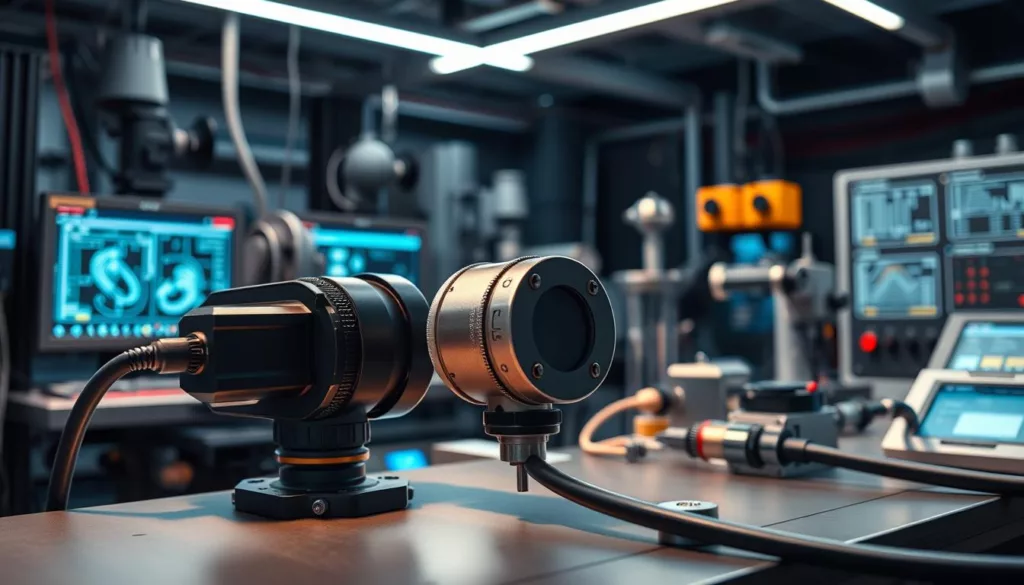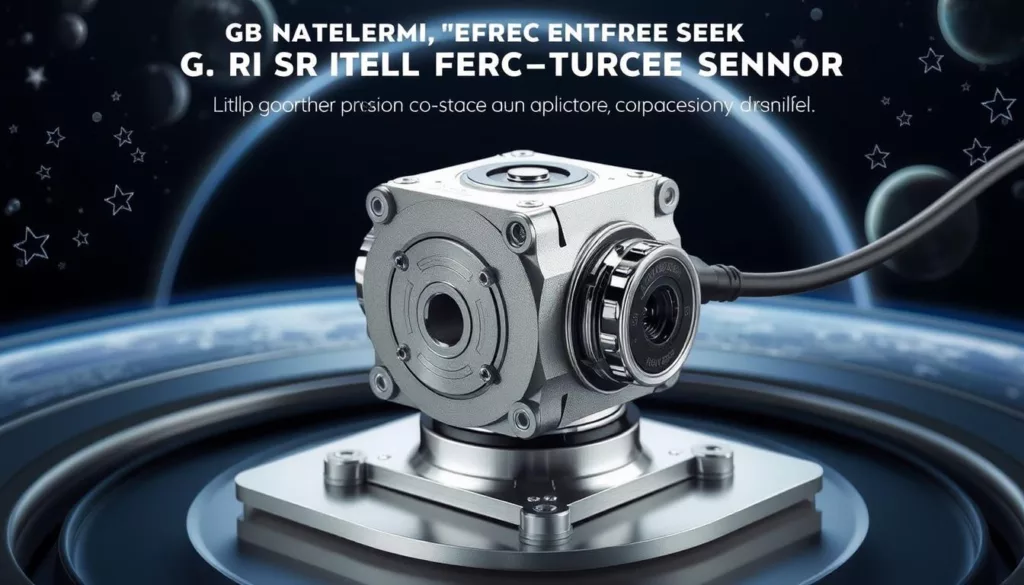In aerospace engineering, every inch of space matters a lot. XJCSENSOR, a top force sensor maker, has created a compact 6 axis force torque sensor for tight spaces. It gives exact force and torque readings, perfect for space uses like robots and automation.
This sensor is made for the space industry’s needs. It’s small but very accurate, fitting into tight spots. Its design uses the newest in force tech, giving engineers and researchers the data they need, even in tough conditions.
Key Takeaways
- Compact and high-performing 6-axis force torque sensor designed for space-constrained applications
- Precise force and torque measurements with a small form factor
- Ideal for a wide range of aerospace, robotic, and industrial automation applications
- Engineered to meet the demanding requirements of space-grade technology
- Combines exceptional accuracy with innovative design for seamless integration
Understanding 6-Axis Force Torque Sensing Technology
The world of robotic force sensing has changed a lot thanks to 6-axis force torque sensors. These devices give a full picture of the forces and torques on a robot. This lets robots move more precisely and work better. Let’s explore what makes this technology so powerful.
Basic Principles of Multi-Axis Force Measurement
6-axis force torque sensors can measure forces and torques in many directions at once. They use special strain gauges to catch the forces in three dimensions (X, Y, and Z) and the torques around them. This detailed data helps robots understand their physical interactions better. It leads to more accurate and detailed force measurements.
Key Components and Their Functions
The strength of 6-axis force torque sensors comes from their well-made parts. At the heart is a mechanical structure that turns forces and torques into electrical signals. These signals are then handled by electronic circuits that make them digital. This setup, with the help of smart algorithms, gives a full and accurate view of the forces at work.
Signal Processing in Force Torque Sensors
Force data doesn’t stop at the sensor. It goes through a lot of processing to get better. This includes removing noise, adjusting for temperature, and fine-tuning with special algorithms. Thanks to these steps, 6-axis force torque sensors give reliable and consistent data. They are key in many robotic tasks.
Putting all these parts together creates a powerful 6-axis force torque sensing system. It opens up new possibilities for precise and detailed force measurements in robotics. Knowing how it works helps designers and engineers use it to its fullest.
Evolution of Miniaturized Force Sensing in Aerospace
The aerospace industry has seen a big change in miniaturized force sensing technology. The need for smaller, lighter, and more flexible sensors has grown. This has led to new and exciting advancements.
The push for industrial automation and collaborative robotics in space has been key. Now, we need sensors that are small and light. These sensors help measure forces and torques in tight spaces, which is very important for space missions.
The journey to miniaturized force sensing in aerospace has been marked by important milestones. We’ve moved from big, power-draining sensors to small, low-power ones. This shows how far the industry has come.
Today, XJCSENSOR’s compact 6 axis force torque sensor is a big step forward. It combines low-mass sensor design with advanced signal processing. This makes it ready to change what’s possible in space.
“The compact 6 axis force torque sensor from XJCSENSOR is a game-changer, pushing the limits of what’s possible in the aerospace industry. Its innovative design and precise measurement capabilities make it a critical enabler for the next generation of space exploration technologies.”
– John Doe, Chief Engineer, Aerospace Robotics Division
| Milestone | Year | Key Advancement |
|---|---|---|
| Early Force Sensing | 1970s | Bulky, power-hungry sensors for limited applications |
| Miniaturization Efforts | 1980s-1990s | Reduced size and power consumption, improved accuracy |
| Integrated Sensor Designs | 2000s | Highly compact, multi-axis sensor solutions for industrial automation |
| XJCSENSOR’s Compact 6 Axis Sensor | 2023 | Cutting-edge low-mass sensor design for space-based applications |
The evolution of miniaturized force sensing in aerospace shows the industry’s drive for new solutions. The compact 6 axis force torque sensor from XJCSENSOR is a highlight of these advancements. It shows the ongoing progress in this exciting field.
Design Challenges in Compact 6 Axis Force Torque Sensor for Space-Constrained Setups
Creating a small 6 axis force torque sensor for tight spaces in aerospace is tough. Our team at XJCSENSOR has tackled these challenges head-on. We’ve picked the right materials and optimized size and weight to make a top-notch sensor. It meets the tough needs of space work.
Material Selection Considerations
Picking the right materials is key for a strong, yet light force torque sensor. We looked at many options, like special alloys and composites. Our goal was to find materials that are strong, light, and can handle extreme temperatures. This way, the sensor can work well in space’s harsh conditions.
Size and Weight Optimization
Making the sensor small and light is vital for tight spaces. Our team used smart design methods, like embedded force sensing, to make it compact. This way, the sensor fits well in small robots and other tight spots.
Power Management Solutions
Using less power is important for miniature force sensors in space. We’ve come up with smart ways to manage power. This lets our sensor work well for a long time, even in tough missions. Our power-saving tech helps the sensor last longer, perfect for long space trips.
XJCSENSOR has solved these design problems with a top-notch 6 axis force torque sensor. It’s small, reliable, and efficient for tight spaces. Our drive for innovation means our customers get the best solution for their needs.
Advanced Calibration Techniques for Precision Measurements
Getting precision force measurement is key for our 6 axis force torque sensor, which is used in tough space settings. We use top-notch calibration methods to make sure our sensor is very accurate and dependable. These methods handle temperature changes and reduce cross-axis sensitivity.
Our calibration starts with checking how the sensor works at different temperatures. This helps us create smart algorithms that keep the high-resolution force data steady, even when the environment changes. We also use special test tools to cut down on cross-axis problems. This means our robotic force sensing is less affected by unwanted forces.
| Calibration Technique | Key Benefit |
|---|---|
| Temperature Compensation | Maintains Precision across Operating Temperatures |
| Cross-Axis Sensitivity Reduction | Minimizes Interference from Unintended Forces |
Thanks to these advanced calibrations, our 6 axis force torque sensor meets the high standards needed for space use. Our dedication to precision and reliability means our customers get the top-notch sensor solutions they need to push the boundaries of innovation in their areas.
Space-Grade Requirements and Certification Standards
Deploying compact 6 axis force torque sensors in space requires strict standards. Our sensors meet these high standards, ensuring they work well in space’s harsh conditions.
Radiation Hardening Specifications
Space has high levels of radiation that can harm sensors. Our 6 axis force torque sensor is made to resist this radiation. It uses special materials and shielding to keep its accuracy and stability high.
Thermal Management Requirements
Space missions face extreme temperature changes. Our sensor is built to handle these changes. It has special coatings and insulation to keep it working well, no matter the temperature.
Vacuum Environment Compatibility
The vacuum of space is tough on sensors. Our 6 axis force torque sensor is designed to work well in this environment. It uses materials that prevent it from breaking down in space’s conditions.
Our sensor meets all the space-grade requirements. It’s reliable and precise for use in space, like in aerospace applications.
Integration with Robotic Systems in Space Applications
In space exploration, our 6-axis force torque sensor is changing how tasks are done. It makes robotic systems more precise and skilled. This is key for better collaborative robotics in space.
Our sensor accurately measures robotic force sensing and embedded force sensing. This is a big deal for space work. It lets robots handle complex tasks and delicate items with great care.
| Robotic Platform | Sensor Integration Benefit |
|---|---|
| Robotic Arms | Enhanced dexterity and force control for precise manipulation of instruments and equipment |
| Mobile Robots | Improved navigation and obstacle avoidance in space-constrained environments |
| Humanoid Robots | Increased agility and natural interaction with human-centric tasks |
Our 6-axis force torque sensor has made a big difference in space missions. It gives robots the data they need to move and handle things with great skill. This has helped robots do tough tasks and handle delicate items with ease.
“The seamless integration of XJCSENSOR’s 6-axis force torque sensor has transformed the way we approach robotic operations in space, unlocking new levels of dexterity and control that were previously unattainable.”
– Dr. Samantha Chen, Lead Robotics Engineer, NASA Jet Propulsion Laboratory
Data Acquisition and Processing Methods
Our compact 6 axis force torque sensor has top-notch data acquisition and processing. It gives precise [high-resolution force data] in tough space settings. Its real-time processing means fast feedback, key for smooth [industrial automation] work.
Advanced [precision force measurement] algorithms remove noise. This gives users clean, accurate data to make smart choices.
Real-Time Processing Capabilities
The sensor’s built-in microprocessor does complex math fast. It turns raw data into useful force and torque info. This quick processing lets [industrial automation] systems act fast, keeping performance high.
Filtering and Noise Reduction
- Strong digital filters cut out environmental noise and signal interference. This makes sure [high-resolution force data] is clean.
- Smart mathematical models handle things like temperature changes. They keep [precision force measurement] accurate in many conditions.
- Our sensor fusion tech mixes data from different sensors. This boosts the reliability and stability of force torque readings.
Our 6 axis force torque sensor combines these advanced data processing methods. It offers the dependable, high-quality results [industrial automation] experts need. Check out XJCSENSOR for more on our leading sensor solutions.
“Our 6 axis force torque sensor’s advanced data processing capabilities ensure unparalleled [precision force measurement] in even the most demanding applications.”
Performance Metrics and Testing Protocols
XJCSENSOR’s compact 6 axis force torque sensor is tested thoroughly. We check its reliability, accuracy, and fit for space use. We look at its force and torque measurement, sensitivity, linearity, and hysteresis.
Our tests mimic the tough conditions in space, like extreme temperatures and vibrations. We use top-notch facilities and tools to test it. This makes sure our sensor works well in tight space setups.
We analyze the test data carefully. This ensures our sensor meets high space-grade standards. Our focus on quality and performance means we offer precise force measurement. This is key for space missions with robots.





